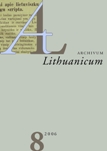Žemaitiškieji rengėjo tapatybės pėdsakai XVIII –XIX amžiaus pagrindiniame katalikų giesmyne 1: Balso širdies pirmojo leidimo kalbos kaita
Traces of the editor's Lowland Lithuanian identity in the basic Catholic hymn-book of the 18th and 19th centuries 1: Linguistic change in the first edition of Balas Širdies (The voice of the heart)
Author(s): Birutė KabašinskaitėSubject(s): Christian Theology and Religion, Theoretical Linguistics, Phonetics / Phonology, Historical Linguistics, Baltic Languages, 18th Century, 19th Century
Published by: Lietuvių Kalbos Institutas
Keywords: Lowland Lithuania; Catholic hymn-book; 18th century; 19th century; Linguistic structure; Balas Širdies;
Summary/Abstract: As late as the seventeenth century, Saliamonas Slavočinskis’ hymnal (SlG) gave a certain impetus to the spread of the Lowland Lithuanian dialect in church poetry, although generally this hymnal represented the central Highland written variety of Lithuanian. This Lowland dialect impulse is very clear in later editions of Balsas Širdies (The Voice of the Heart, 1726; BŠ), which replaced Slavočinskis’ hymnal. The editor of the BŠ is very likely to have been a Lowlander, who was quite familiar with the Highland dialects of Lithuanian. Thus, although his intentions were to write in central Highland written Lithuanian, there remain many traces of the Lowland Lithuanian dialect. The heterogeneity of the language of BŠ was also determined by the three sources of the hymnal: SlG (Central Highland written Lithuanian and the Lowland dialect), Knyga Nobažnystės (Book of Devotion, 1653; KN) (Central Highland written Lithuanian) and the anonymous translation of Bellarmin’s Catechism (1677; BK) (Eastern Highland written Lithuanian). In some cases these three sources were used in a rather peculiar way. The adopted hymns and psalms had not only been greatly revised but they had been often composed from the text fragments of various sources. Out of 154 texts of BŠ (114 hymns and 40 psalms) obviously only 29 (25 hymns and 4 psalms) are new. It seems that for the editor it was most important to revise those already existing texts but not to create new ones.
Journal: Archivum Lithuanicum
- Issue Year: 2006
- Issue No: 08
- Page Range: 149-186
- Page Count: 38
- Language: Lithuanian

